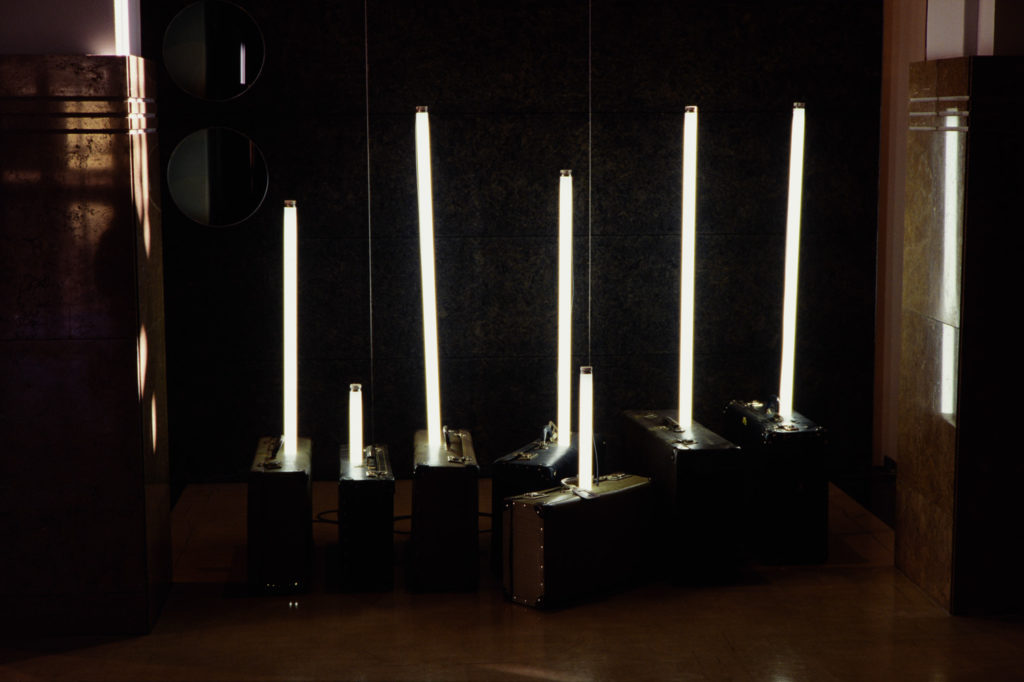SPONSORS Rutherford Trust, British Council, British High Commission PUBLICATION essays Yves Abrioux, Christina Barton, Francis Pound, Lara Strongman OTHER VENUES Dunedin Public Art Gallery, 27 June - 6 September 1998
Expat New Zealand artist Bill Culbert is known for his works exploring and representing light effects—a perennial theme in art history.
Born in Port Chalmers in 1935, Culbert leaves New Zealand as a young man—in 1957—to study at the Royal College in London. In 1968, he begins making the electric-light sculptures that will become his forte. While residing in the UK and France, he continues to exhibit in New Zealand.
Culbert says: ‘I wanted to use light because it has no space or distance. Where the work finishes is only where you can’t see the light anymore.’ Consisting of wall-based sculptures, installations, and black-and-white photographs, Lightworks samples Culbert’s work of the last six years.
In his sculptures, Culbert uses standard and found light fittings (frosted and clear incandescent bulbs, standard fluoro tubes, lamps, lampshades), often in combination with other humble found objects (plastic bottles, wine glasses, glass jars, suitcases).
Many of Culbert’s sculptures explore the way materials—transparent and translucent, reflective and opaque—mediate light. In Total Black, Total White, Total Red, and Total Silver (1991), grids of identical rectilinear plastic bottles are penetrated with fluoro tubes, so we can observe the mediating effects of the different plastics on the backlighting. In Plain of Jars (1996), dozens of glass jars sit on a wooden table, each containing a small glowing bulb. Some jars are clear, others painted fully or partly, white or black, modifying the play of light within and between them.
In Blind Window (1991) and Light Fall (1992), fluoro tubes are arranged to suggest diagrams representing light falling through a window, forcing an analogy between fluoro tubes and beams of light. In Light Plain (1995), around 200 lightbulbs in standard cheap conical plastic lampshades are hung to suggest rectangular plane skewed to the room. Culbert plays on the way our eye wants to see a single shape rather than individual lights.
Culbert is also a photographer. Collected, his black-and-white images suggest a diary, emphasising the way his work is rooted in observation. Some shots document works and studio experiments, some may document phenomena the artist merely chanced upon. Wine Work (1992) shows wineglasses on a rustic wooden table in natural light. Paradoxically, the glasses are visually dominated by the insubstantial shadows they cast.
Culbert’s focus is formal, optical, phenomenological, and yet poetic metaphors also enter the frame. Take Hotel Voyageur (1990), in the Gallery foyer, where fluoro tubes inexplicably but suggestively puncture old suitcases.
The show isn’t limited to the Gallery. A truck is parked outside the Gallery. Its raised loading tray bears Culbert’s latest lightbox, Skylight 3 (1997), which appears to reflect the luminescent blue sky. Behind it, Culbert’s earlier collaboration, with Ralph Hotere, Fault (1994), is permanently installed on the Gallery’s facade. Both run day and night, 24/7.
In Sunday Star Times, Mark Amery writes, ‘In his work, light is the actual subject, the magic itself.’ He declares the show, ‘An exhibition that has such elegant poetic power that it’s too good to ignore.’









































